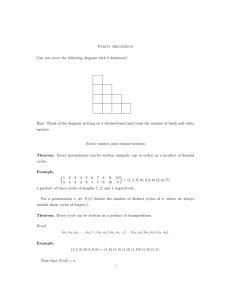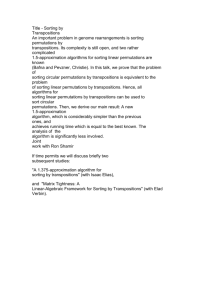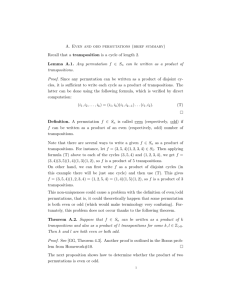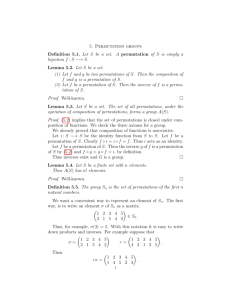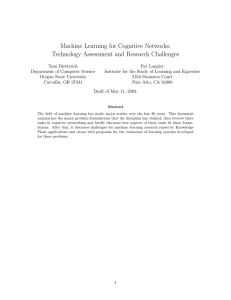AN ANALYSIS OF THE 15-PUZZLE 1. Basics 1.1. Permutations. A
advertisement
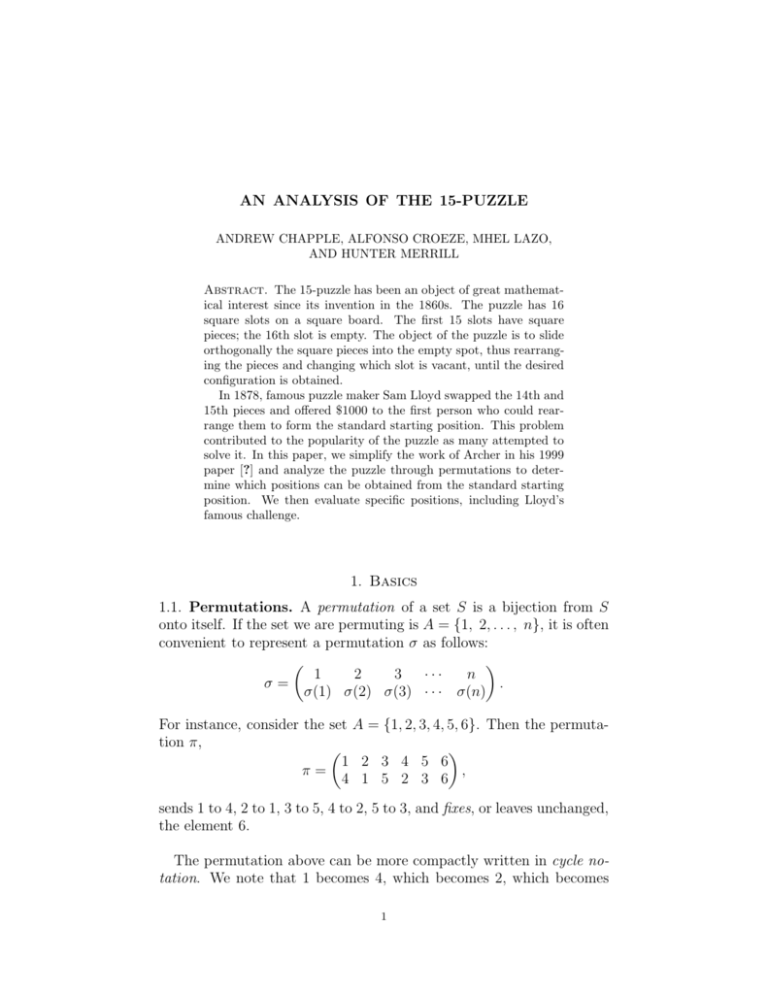
AN ANALYSIS OF THE 15-PUZZLE
ANDREW CHAPPLE, ALFONSO CROEZE, MHEL LAZO,
AND HUNTER MERRILL
Abstract. The 15-puzzle has been an object of great mathematical interest since its invention in the 1860s. The puzzle has 16
square slots on a square board. The first 15 slots have square
pieces; the 16th slot is empty. The object of the puzzle is to slide
orthogonally the square pieces into the empty spot, thus rearranging the pieces and changing which slot is vacant, until the desired
configuration is obtained.
In 1878, famous puzzle maker Sam Lloyd swapped the 14th and
15th pieces and offered $1000 to the first person who could rearrange them to form the standard starting position. This problem
contributed to the popularity of the puzzle as many attempted to
solve it. In this paper, we simplify the work of Archer in his 1999
paper [?] and analyze the puzzle through permutations to determine which positions can be obtained from the standard starting
position. We then evaluate specific positions, including Lloyd’s
famous challenge.
1. Basics
1.1. Permutations. A permutation of a set 𝑆 is a bijection from 𝑆
onto itself. If the set we are permuting is 𝐴 = {1, 2, . . . , 𝑛}, it is often
convenient to represent a permutation 𝜎 as follows:
(
)
1
2
3
⋅⋅⋅
𝑛
𝜎=
.
𝜎(1) 𝜎(2) 𝜎(3) ⋅ ⋅ ⋅ 𝜎(𝑛)
For instance, consider the set 𝐴 = {1, 2, 3, 4, 5, 6}. Then the permutation 𝜋,
(
)
1 2 3 4 5 6
𝜋=
,
4 1 5 2 3 6
sends 1 to 4, 2 to 1, 3 to 5, 4 to 2, 5 to 3, and fixes, or leaves unchanged,
the element 6.
The permutation above can be more compactly written in cycle notation. We note that 1 becomes 4, which becomes 2, which becomes
1
2
CHAPPLE, CROEZE, LAZO, MERRILL
1; we express this as the cycle (1 4 2) (cycles are always read left to
right). Similarly, 3 becomes 5 which becomes 3, so we write that as
(3 5). The element 6 does not change, so that part of the permutation
is written simply as (6). Altogether, the cyclic description of 𝜋 is
𝜋 = (1 4 2)(3 5)(6).
However, since the cycle (6) does not actually change anything, it may
be omitted:
𝜋 = (1 4 2)(3 5)
In this example the two cycles which compose 𝜋 are disjoint, having no
common elements, and so they commute. Therefore, we can also write
𝜋 as
𝜋 = (3 5)(1 4 2).
In this paper, when nondisjoint cycles are to be performed in succession, the rightmost cycle is performed first. Cycles which consist
of only two elements, such as the cycle (3 5) in 𝜋, are referred to as
2-cycles, or more commonly, as transpositions. The transposition (3 5)
can also be written as (5 3), as both have the effect of swapping the
elements 3 and 5. Subsequently, any transposition is its own inverse.
Theorem 1.1. Every cycle may be written as a product of
transpositions.
Proof. Consider a cycle 𝐶,
𝐶 = (𝑥1 𝑥2 𝑥3 𝑥4 . . . 𝑥𝑘−2 𝑥𝑘−1 𝑥𝑘 )
where 𝑥𝑖 is an element of the set being permuted. Then 𝐶 may be
expressed as
𝐶 = (𝑥1 𝑥𝑘 )(𝑥1 𝑥𝑘−1 ) . . . (𝑥1 𝑥4 )(𝑥1 𝑥3 )(𝑥1 𝑥2 ).
To see that this works, note that 𝑥1 becomes 𝑥2 by the rightmost transposition. For all other 𝑥𝑖 , 𝑖 < 𝑘, 𝑥𝑖 will become 𝑥1 by the transposition
(𝑥1 𝑥𝑖 ), and it will subsequently become 𝑥𝑖+1 by the next transposition,
(𝑥1 𝑥𝑖+1 ).
□
Refering back to our previous example, we consider the number of
possible permutations on the set 𝐴. Note that we have 6 choices for
the first element to which we want to assign an output, the numbers
1 to 6. The second element we examine has 5 possible outputs, since
we already assigned one of the numbers 1 to 6 to the first element
AN ANALYSIS OF THE 15-PUZZLE
3
and cannot repeat them. Continuing in this manner, there are thus
6 ∗ 5 ∗ 4 ∗ 3 ∗ 2 ∗ 1 = 6! = 720 permutations of the set 𝐴. Using a
similar method, it can be easily demonstrated that, given a set with 𝑛
elements, there are 𝑛! permutations of that set.
The set of all permutations of a set 𝑆 = {1, 2, . . . , 𝑛} is called the
symmetric group on 𝑛 letters, and is denoted 𝑆𝑛 . We showed in the
previous paragraph that
∣𝑆𝑛 ∣ = 𝑛!
Now, let us once again refer to our permutation 𝜋. Using the technique
of Theorem ??, we write 𝜋 as
𝜋 = (1 4 2)(3 5) = (1 2)(1 4)(3 5).
Note that we used an odd number of transpositions to express 𝜋, and
thus call 𝜋 an odd permutation. Any permutation which may be written as the product of an odd number of transpositions is called odd;
otherwise, we call it even.
Sometimes, when working with 𝑆𝑛 , we only want to consider permutations of one parity. The set of odd permutations in 𝑆𝑛 is denoted by
𝑂𝑛 , and the alternating group, or the set of even permutations in 𝑆𝑛 ,
is denoted by 𝐴𝑛 .
A few more theorems are necessary.
Theorem 1.2. The identity 𝐼, the permutation which fixes all elements, is even.
(Grove, p.17). To show that the identity is even, we need to show
that it is not possible to write it as the product of an odd number of transpositions. Suppose, to the contrary, that we have done
so, 1 = (𝑎𝑏) ⋅ ⋅ ⋅ , using a minimal number of transpositions and with
the smallest possible number of 𝑎’s appearing. At least one more 𝑎
must appear, since 1𝑎 ∕= 𝑏, so suppose (𝑎𝑐) is the next one to the
right. Note that (𝑑𝑒)(𝑎𝑐) = (𝑎𝑐)(𝑑𝑒) if (𝑑𝑒) and (𝑎𝑐) are disjoint and
(𝑑𝑐)(𝑎𝑐) = (𝑎𝑑)(𝑐𝑑), so we may move the second 𝑎 to the left and write
1 = (𝑎𝑏)(𝑎𝑓 ) ⋅ ⋅ ⋅ , with the same minimality conditions met. But now if
𝑏 = 𝑓 we may reduce the number of transpositions by 2, and if 𝑏 ∕= 𝑓 ,
then (𝑎𝑏)(𝑎𝑓 ) = (𝑎𝑓 )(𝑏𝑓 ) and we may reduce the number of 𝑎’s, in
both cases a contradiction.
□
4
CHAPPLE, CROEZE, LAZO, MERRILL
Theorem 1.3. If 𝜎 ∈ 𝑆𝑛 , then 𝜎 may be written as the product of an
even number of transpositions if and only if 𝜎 can not be written as the
product of an odd number of transpositions.
Proof. Suppose 𝜎 can be written as a product of transpositions in two
ways. Then we may write:
𝜎 = 𝜏1 𝜏2 ⋅ ⋅ ⋅ 𝜏𝑠 = 𝑞1 𝑞2 ⋅ ⋅ ⋅ 𝑞𝑡
Multiply both sides by the inverse of the right hand side,
𝜏1 𝜏2 ⋅ ⋅ ⋅ 𝜏𝑠 (𝑞1 𝑞2 ⋅ ⋅ ⋅ 𝑞𝑡 )−1 = 𝑞1 𝑞2 ⋅ ⋅ ⋅ 𝑞𝑡 (𝑞1 𝑞2 ⋅ ⋅ ⋅ 𝑞𝑡 )−1
𝜏1 𝜏2 ⋅ ⋅ ⋅ 𝜏𝑠 (𝑞1 𝑞2 ⋅ ⋅ ⋅ 𝑞𝑡 )−1 = 𝐼
−1
𝜏1 𝜏2 ⋅ ⋅ ⋅ 𝜏𝑠 𝑞𝑡−1 𝑞𝑡−1
⋅ ⋅ ⋅ 𝑞1−1 = 𝐼
𝜏1 𝜏2 ⋅ ⋅ ⋅ 𝜏𝑠 𝑞𝑡 𝑞𝑡−1 ⋅ ⋅ ⋅ 𝑞1 = 𝐼
The left hand side is a product of 𝑠+𝑡 transpositions. Since Theorem ??
showed that the identity on the right hand side is even, 𝑠 and 𝑡 must
have the same parity.
□
Theorem 1.4. ∣𝑂𝑛 ∣ = ∣𝐴𝑛 ∣ =
𝑛!
.
2
Proof. Fix 𝜎 ∈ 𝑆𝑛 . Let 𝑓 (𝜎) = (1 2)𝜎 Note that
{
𝐴𝑛 if 𝜎 ∈ 𝑂𝑛
𝑓 (𝜎) ∈
𝑂𝑛 if 𝜎 ∈ 𝐴𝑛 .
Consider any 𝜎1 , 𝜎2 ∈ 𝑆𝑛 . If 𝑓 (𝜎1 ) = 𝑓 (𝜎2 ), then
(1 2)𝜎1 = (1 2)𝜎2
(1 2)(1 2)𝜎1 = (1 2)(1 2)𝜎2
𝜎1 = 𝜎2
Therefore, 𝑓 is injective.
Now consider any 𝜎2 ∈ 𝑆𝑛 . Then since
𝑓 ((1 2)𝜎2 ) = (1 2)(1 2)𝜎2 = 𝜎2 ,
we have that 𝑓 is surjective.
Since 𝑓 is injective and surjective, 𝑓 is bijective.
This means that every 𝜎1 ∈ 𝐴𝑛 can be mapped to exactly one 𝜎2 ∈
𝑂𝑛 . Likewise, every element of 𝑂𝑛 is mapped to exactly one element
of 𝐴𝑛 . Therefore,
∣𝑂𝑛 ∣ = ∣𝐴𝑛 ∣
AN ANALYSIS OF THE 15-PUZZLE
5
By Theorem ??, every element in 𝑆𝑛 belongs to exactly one of 𝐴𝑛 or
𝑂𝑛 . So,
∣𝑂𝑛 ∣ + ∣𝐴𝑛 ∣ = ∣𝑆𝑛 ∣
2∣𝐴𝑛 ∣ = ∣𝑆𝑛 ∣
∣𝑆𝑛 ∣
𝑛!
∣𝐴𝑛 ∣ =
=
2
2
□
1.2. Groups. A group is a combination of a set 𝑆 and a binary operation ∗ that has the following properties:
(1) The set is non-empty.
(2) The set is closed under the operation; the result of the operation
on any two elements of the set must be another element in the
set.
(3) The set is associative: (𝑎 ∗ 𝑏) ∗ 𝑐 = 𝑎 ∗ (𝑏 ∗ 𝑐).
(4) The set contains an identity (denoted by 𝐼, Id or 𝑒) that fixes
any element 𝜎 ∈ 𝑆.
(5) The set must contain an inverse for each element in the set;
for any 𝜎 ∈ 𝑆, there exists another element 𝜎 ′ ∈ 𝑆 such that
𝜎 ∗ 𝜎 ′ = 𝜎 ′ ∗ 𝜎 = 𝐼.
Examples of groups include the integers under addition, 𝑆𝑛 , and 𝐴𝑛 .
A subset 𝐻 of a group 𝐺 is called a subgroup of 𝐺 if the operation on
𝐺 restricts to a binary operation on 𝐻 under which 𝐻 is itself a group.
2. The Puzzle
Before an analysis of the 15-puzzle can be accomplished, we must
specify that the permutations of the puzzle are performed on the positions of the puzzle, rather than the contents of the positions. That
is, a transposition (1 2) will swap the contents of positions 1 and 2,
rather than swapping contents labeled 1 and 2. The positions of our
15-puzzle will be labeled like this:
4
3
2
1
5
6
7
8
12 11 10
9
13 14 15 16
6
CHAPPLE, CROEZE, LAZO, MERRILL
This labeling follows a specific path from position 1 to the position
16 that will be called the “snake” path for the remainder of this paper.
The contents of the positions of our 15-puzzle will be labeled using letters to avoid some confusion (note that, as we are permutating
positions, the actual labels of the contents do not matter):
𝐴
𝐵 𝐶 𝐷
𝐸
𝐹
𝐺 𝐻
𝐼
𝐽
𝐾
𝑀 𝑁
𝑂
𝐿
This configuration will be called the “initial” configuration for the remainder of the paper. As an example, if one wanted to swap F and J,
the transposition required to do so is (6 11).
Define the following set:
𝐺 = {all possible configurations, with the blank space anywhere}
For any configuration 𝑃 ∈ 𝐺, define 𝑃 ′ to be the configuration where
the blank in 𝑃 has been snaked to position 16. In some cases, 𝑃 = 𝑃 ′.
We will call 𝑃 ′ the standardization of 𝑃 .
Lemma 2.1. Fix 𝑃1 , 𝑃2 ∈ 𝐺 and consider 𝑃1′ and 𝑃2′ . 𝑃1 can be
changed to 𝑃2 via legal moves if and only if 𝑃1′ can be changed to 𝑃2′
via legal moves.
Proof. First, assume 𝑃1′ can be changed to 𝑃2′ . Then, we can change
𝑃1 to 𝑃2 by changing 𝑃1 to 𝑃1′ , 𝑃1′ to 𝑃2′ , and then 𝑃2′ to 𝑃2 . Similarly,
if we assume that the change from 𝑃1 to 𝑃2 is possible, then we can
change 𝑃1′ to 𝑃2′ by changing 𝑃1′ to 𝑃1 , 𝑃1 to 𝑃2 , and then 𝑃2′ to 𝑃2 . □
This lemma may seem trivial, but it in fact greatly reduces the number of board configurations which need to be evaluated as we may now
consider only configurations in 𝐺 for which the blank is in position
16. Denote by 𝐾 ⊂ 𝐺 all configurations of the board for which the
blank is in position 16. We note that legal moves consist of transposing
the position the blank occupies with one of the orthogonally adjacent
positions, which we call neighbors. Since we are considering only configurations in 𝐾, our blank must start and end at position 16. So our
legal moves, denoted 𝐿(𝐾) are permutations of the form:
(𝑖𝑘 = 16 𝑖𝑘−1 )(𝑖𝑘−1 𝑖𝑘−2 ) ⋅ ⋅ ⋅ (𝑖3 𝑖2 )(𝑖2 𝑖1 )(𝑖1 𝑖0 = 16)
where 𝑖𝑠 is a neighbor of 𝑖𝑠+1 for 0 ≤ 𝑠 < 𝑘
Lemma 2.2. 𝐿(𝐾) is a group.
AN ANALYSIS OF THE 15-PUZZLE
7
Proof. We will show that 𝐿(𝐾) fulfills all the properties of a group:
(1) 𝐿(𝐾) is nonempty. As an example we have (16 15)(15 16),
which also happens to be the identity.
(2) Given a permutation in 𝐿(𝐾), performing the permutation in
reverse order yields its inverse.
(3) Permutation composition is an associative binary operation.
(4) Any permuation in 𝐿(𝐾) begins and ends with a transposition including position 16, therefore compositions of elements
of 𝐿(𝐾) will still be in 𝐿(𝐾).
□
Lemma 2.3. 𝐿(𝐾) ≤ 𝐴15 .
Proof. Going from one configuration to another, we had to move the
blank space around, but we always returned it to 16. If we moved
it left, we always had to move it back right; if we moved it up, we
always had to move it back down. As a result, we always used an
even number of swaps to change configurations; therefore, we used an
even number of transpositions. This tells us that no odd permutation
could ever describe a configuration legally obtained from the initial
configuration. Of all the permutations in 𝑆15 , only those in 𝐴15 are
potentially possible. Therefore, 𝐿(𝐾) ⊆ 𝐴15 . Since we have already
shown that 𝐿(𝐾) is a group, it immediately follows that 𝐿(𝐾) ≤ 𝐴15 .
□
There are legal moves, associated with nine transpositions, which
swap two tiles not along the snaked path.
For example, we want to determine how the move associated with
(11 14) changes the board. Starting with the blank at 16, we move it
along the snake until we reach the first position used in the transposition (in this case, 14), perform the transposition, then move the blank
along the path back to 16; the blank’s path is 16, 15, 14, 11, 12, 13,
14, 15, 16. Continuing in this way, we get the permutation:
(16 15)(15 14)(14 13)(13 12)(12 11)(11 14)(14 15)(15 16) = (13 12 11)
This permutation is clearly an element of 𝐿(𝐾), and we denote it by
𝑆11,14 . The others are listed below.
8
CHAPPLE, CROEZE, LAZO, MERRILL
𝑆9,16
𝑆10,15
𝑆11,14
𝑆7,10
𝑆6,11
𝑆5,12
𝑆1,8
𝑆2,7
𝑆3,6
=
=
=
=
=
=
=
=
=
(15 14 13 12 11 10 9)
(14 13 12 11 10)
(13 12 11)
(9 8 7)
(10 9 8 7 6)
(11 10 9 8 7 6 5)
(7 6 5 4 3 2 1)
(6 5 4 3 2)
(5 4 3)
Note that
−1
𝑆9,16
= (9 10 11 12 13 14 15)
−1
𝑆10,15
= (10 11 12 13 14)
..
.
−1
𝑆3,6 = (3 4 5)
3. The Result
When moving the tiles around the board, we were working in 𝑆16
since there are 16 total squares whose contents we were changing. However, because we only considered configurations where the blank was
in 16, we never changed the contents of 16 in going from one configuration to another; since we effectively fixed 16, we were really working
in 𝑆15 . By Lemma ??, we showed that only even permutations, i.e. the
permutations in 𝐴15 , are possible. But which ones?
The following two theorems will help address this question.
Theorem 3.1. Every element of 𝑆𝑛 may be written as a product of
transpositions of the form (𝑘 𝑘 + 1).
Proof. Choose 𝜎 ∈ 𝑆𝑛 and select transpositions 𝜏1 , . . . 𝜏𝑘 (possibly by
using the technique shown in Theorem ??) such that
𝜎 = 𝜏1 𝜏2 𝜏3 . . . 𝜏𝑘
Every 𝜏𝑖 can be written in the following way:
For each 𝜏𝑖 , we may write for distinct 𝑘, 𝑙 ∈ 1, 2, . . . , 𝑛 𝜏𝑖 = (𝑘 𝑙).
Since (𝑘 𝑙) = (𝑙 𝑘), we assume WLOG that 𝑘 < 𝑙. Then,
AN ANALYSIS OF THE 15-PUZZLE
9
𝜏𝑖 = (𝑘 𝑙)
which we may then expand to get
𝜏𝑖 = (𝑘 𝑘 + 1)(𝑘 + 1 𝑘 + 2) ⋅ ⋅ ⋅ (𝑙 −1 𝑙)(𝑙 −2 𝑙 −1) ⋅ ⋅ ⋅ (𝑘 + 1 𝑘 + 2)(𝑘 𝑘 + 1)
Repeating this for 𝑖 = 1, 2, . . . , 𝑘 we get 𝜎 as a product of adjacent
transpositions.
□
Theorem 3.2. Every element of 𝐴𝑛 can be written as a product of
cycles of the form (𝑘 𝑘 + 1 𝑘 + 2).
Proof. From Theorem ??, we found that every permutation can be
written as a product of adjacent transpositions of the form
(𝑘 𝑘 + 1)(𝑘 + 1 𝑘 + 2) ⋅ ⋅ ⋅ (𝑙 − 1 𝑙)(𝑙 − 2 𝑙 − 1) ⋅ ⋅ ⋅ (𝑘 + 1 𝑘 + 2)(𝑘 𝑘 + 1)
Focusing on two “side-by-side” adjacent transpositions at a time, we
find the following three cases:
(1) (𝑘 𝑘 + 1)(𝑘 + 1 𝑘 + 2)
(2) (𝑘 + 1 𝑘 + 2)(𝑘 𝑘 + 1)
(3) (𝑎 𝑎 + 1)(𝑏 𝑏 + 1) where {𝑎, 𝑎 + 1} ∩ {𝑏, 𝑏 + 1} = ∅
We may rewrite the first two cases as follows:
(1) (𝑘 𝑘 + 1)(𝑘 + 1 𝑘 + 2) = (𝑘 𝑘 + 1 𝑘 + 2)
(2) (𝑘 + 1 𝑘 + 2)(𝑘 𝑘 + 1) = (𝑘 𝑘 + 2 𝑘 + 1)
For the third case, we assume WLOG (since disjoint permutations
commute) that 𝑎 < 𝑏. Then we may rewrite (𝑎 𝑎 + 1)(𝑏 𝑏 + 1) as
(𝑎 𝑎 + 1)(𝑎 + 1 𝑎 + 2)(𝑎 + 1 𝑎 + 2) ⋅ ⋅ ⋅ (𝑏 − 1 𝑏)(𝑏 − 1 𝑏)(𝑏 𝑏 + 1).
Since (𝑎 𝑎 + 1)(𝑏 𝑏 + 1) is an even permutation, the permutation above
on the right side will have an even number of transpositions. We may
then use the first case to rewrite the transpositions as needed.
Since elements of 𝐴𝑛 use an even number of adjacent transpositions,
no transposition is omitted when we combine them in such a way.
Therefore, every element of 𝐴𝑛 can be written as a product of cycles
of the forms
(𝑘 𝑘 + 1 𝑘 + 2)
or
(𝑘 𝑘 + 2 𝑘 + 1).
However, since
(𝑘 𝑘 + 1 𝑘 + 2) = (𝑘 𝑘 + 2 𝑘 + 1)2
all elements can actually be written using only the form
10
CHAPPLE, CROEZE, LAZO, MERRILL
(𝑘 𝑘 + 1 𝑘 + 2).
□
So, we wish to show that all cycles of the form (𝑘 𝑘 + 1 𝑘 + 2) can be
formed using the nine vertical transpositions presented earlier. Note
that we already have (3 4 5), (7 8 9), and (11 12 13) as inverses of
cycles formed from three of the transpositions. The other necessary
cycles are listed here.
(1 2 3)
(2 3 4)
(4 5 6)
(5 6 7)
(6 7 8)
(8 9 10)
(9 10 11)
(10 11 12)
(12 13 14)
(13 14 15)
=
=
=
=
=
=
=
=
=
=
(1 2 3 4 5 6 7)−2 (3 4 5)(1 2 3 4 5 6 7)2
(1 2 3 4 5 6 7)−1 (3 4 5)(1 2 3 4 5 6 7)
(1 2 3 4 5 6 7)−1 (5 6 7)(1 2 3 4 5 6 7)
(5 6 7 8 9 10 11)−2 (7 8 9)(5 6 7 8 9 10 11)2
(5 6 7 8 9 10 11)−1 (7 8 9)(5 6 7 8 9 10 11)
(5 6 7 8 9 10 11)−1 (9 10 11)(5 6 7 8 9 10 11)
(9 10 11 12 13 14 15)−2(11 12 13)(9 10 11 12 13 14 15)2
(9 10 11 12 13 14 15)−1(11 12 13)(9 10 11 12 13 14 15)
(9 10 11 12 13 14 15)(11 12 13)(9 10 11 12 13 14 15)−1
(9 10 11 12 13 14 15)2 (11 12 13)(9 10 11 12 13 14 15)−2
We have shown that all permutations of the form (𝑘 𝑘 + 1 𝑘 + 2) are
possible, and since we know from Theorem ?? that all permutations in
𝐴𝑛 can be generated from those permutations, we have in fact shown
that all permutations in 𝐴15 can be legally obtained: that is, 𝐿(𝑘) =
𝐴15 .
However, the initial configuration does not have to be the “normal”
starting configuration we included earlier; it could be any standard
configuration. But, by Lemma ??, we know that any configuration can
be changed to an equivalent standard configuration. We can therefore
state our result as follows.
Theorem 3.3. A given configuration of the 15-puzzle can be changed
legally into another configuration if and only if the standardardized
forms of the configurations can be transformed into each other by an
even permutation.
Thus, by Theorem ??, there are
dard configurations.
15!
2
= 653, 837, 184, 000 legal stan-
AN ANALYSIS OF THE 15-PUZZLE
11
4. Applications
One configuration worth mentioning is the configuration in which the
contents of the positions are placed in reverse order. In keeping with
the definition above in which the positions are labeled in consecutive
order along the “snake” and the contents of each position are labeled
in consecutive order following the traditional left-to-right and top-tobottom scheme, the change from the initial position to the reverse-order
configuration would look like this:
𝑂 𝑁 𝑀
𝐿
𝐾
𝐽
𝐼
𝐻
𝐺 𝐹
𝐸
𝐷
𝐶
𝐴
𝐵
To attain this configuration, the contents of the 4 and 15 positions
must be swapped, the 3 and 14, etc. This move can be written as a
product of transpositions:
(15 4)(14 3)(13 2)(9 1)(10 5)(11 6)(12 7)
This configuration requires an odd number of transpositions and is
thus impossible to obtain from the starting configuration using only
legal moves. Conversely, no legal configurations are attainable from
this configuration using only legal moves.
Now let us examine Sam Lloyd’s configuration:
𝐴 𝐵 𝐶 𝐷
𝐸
𝐹
𝐺 𝐻
𝐼
𝐽
𝐾
𝐿
𝑀 𝑂 𝑁
Only the N and O have been moved from their initial positions, so
we can describe this configuration, relative to the initial configuration,
with a single transposition: (14 15). But, since we used an odd number of transpositions, we immediately conclude that this configuration
could not have been obtained legally from the normal initial configuration. One should always be wary of a mathematician’s challenge.
Another configuration of interest is the 1-blank, in which the blank
is in the top left corner and the contents of every position are shifted
12
CHAPPLE, CROEZE, LAZO, MERRILL
to the right one place:
𝐴
𝐵 𝐶
𝐷
𝐸
𝐹
𝐺
𝐻
𝐼
𝐽
𝐾
𝐿 𝑀 𝑁
𝑂
Standardize the configuration:
𝐷
𝐴 𝐵 𝐶
𝐸
𝐹
𝐺 𝐾
𝐿
𝐻
𝐼
𝐽
𝑀 𝑁 𝑂
Is this configuration possible? To achieve this configuration from the
initial configuration, one must use the permutation
(12 9)(12 10)(11 10)(8 10)(2 1)(3 1)(4 1)
This permutation is odd, and thus the configuration is impossible to
obtain through legal moves.
Acknowledgements
We thank Dr. Robet Perlis for introducing the problem and delivering numerous lectures about the material, as well as Dennis Hall, our
mentor, for his guidance and insightful discussions. We also thank the
faculty and managers of the VIGRE SMILE@LSU program for their
encouragement and financial support.
References
[1] Grove, Larry. Algebra. NY, Dover Pubs, 1983.
[2] Archer,
Aaron F. A Modern Treatment
American Math Monthly 106. Nov. 1999.
of
the
15
Puzzle.
AN ANALYSIS OF THE 15-PUZZLE
Louisiana State University, Baton Rouge, Louisiana
E-mail address: achapp1@lsu.edu
Louisiana State University, Baton Rouge, Louisiana
E-mail address: acroez1@lsu.edu
Louisiana State University, Baton Rouge, Louisiana
E-mail address: mlazo1@lsu.edu
Mississippi State University, Mississippi State, Mississippi
E-mail address: hrm71@msstate.edu
13

